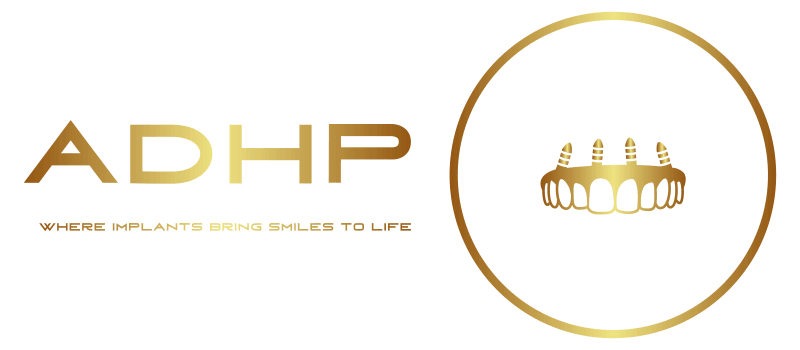Low Cost Dental Implants: Your Pathway to a Brighter Smile
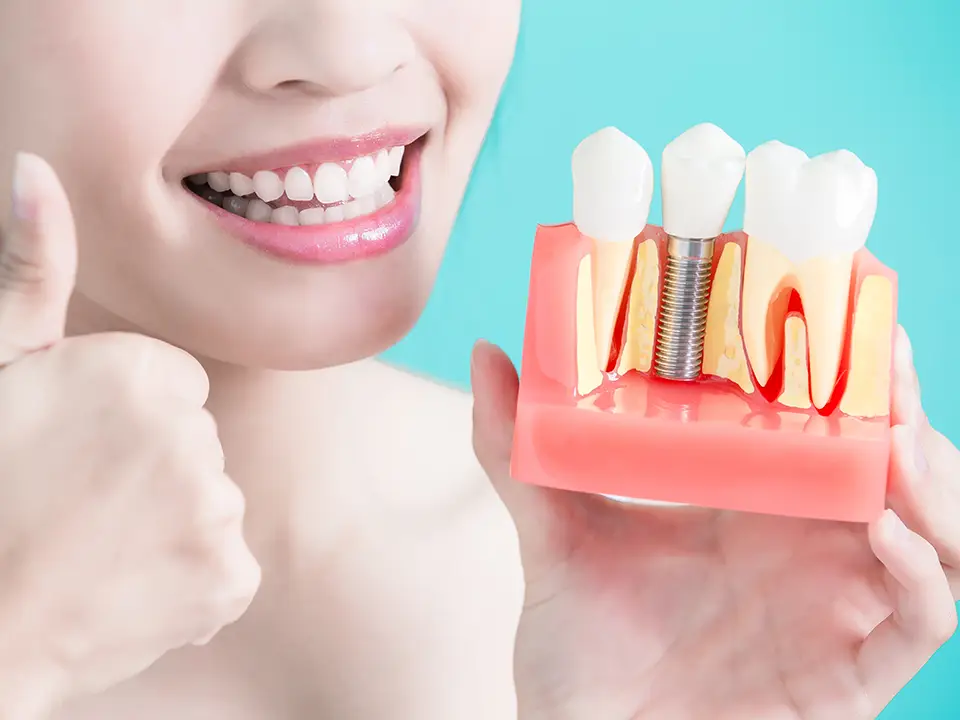
Hello there! It’s wonderful to have you with us today. We understand that oral health is essential to you. We’re also aware that costs related to dental care can sometimes seem overwhelming. But it doesn’t always have to be like this. Let’s explore how low cost dental implants can give you the perfect smile you’ve always dreamed of. What Are Dental Implants First, let’s explain dental implants in a way that’s easy to understand. Picture your teeth. Each tooth has two main parts: the crown (the part you can see) and the root (the part under your gums, in your jawbone). When you lose a tooth, you lose both parts. This is where dental implants come in. Dental implants are like metal posts or frames. They’re made from medical-grade titanium, a material that’s super strong and safe for your body. A dentist or oral surgeon places these implants into your jawbone, right where your tooth roots used to be. Over time, these implants stick to your natural bone, just like how a plant’s roots stick into the ground. This process is called osseointegration. It may sound like a big word, but it simply means that the implant and your bone grow together. This creates a super strong base for your new tooth or teeth. Once the implant and your bone have become best buddies, it’s time for the next step. The dentist will attach something called an abutment to the implant. The abutment is like a connector. It links the implant with the replacement tooth, or crown. What is a Dental Crown? The crown is made to match your natural teeth. It’s usually made of porcelain or ceramic material, and it’s shaped and colored to look just like a real tooth. This way, no one will even know that you’ve had a dental implant – they’ll just see your bright, confident smile! Even though they help bring back bright smiles, people often think dental implants are too expensive. But it’s time to think differently. Cheap dental implants can be just as good as more expensive ones, and they can give you back the smile you deserve. Let’s find out more about that next. Remember, dental implants aren’t scary or confusing. They’re simply a great way to replace missing teeth and help you feel good about your smile again. And with low-cost options available, they’re more accessible than ever before. Cheap Dental Implants Are Real! Yes, you read that right. Low-cost dental implants are not just a dream but a reality. So, if you’ve been holding off on improving your smile due to concerns about cost, you might be surprised to learn that cheap dental implants are an actual possibility. Now, let’s clear the air. When we say “cheap dental implants,” we don’t mean low-quality. Instead, we’re talking about high-quality dental implants at a low cost. The term “cheap” refers only to the price, not to the quality of the care you’ll receive. Your smile is important, and you should never have to compromise on quality. But how can dental implants be both of high-quality and affordable? This is possible due to the advancements in dental technology and techniques. Better technology makes the process of placing dental implants more efficient, and efficiency translates to less time in the dentist’s chair and less cost for you. More Dental Implants The growing competition among dental implant providers also contributes to the existence of cheap dental implants. With numerous providers out there, each is striving to attract patients. This competition often leads to more affordable prices without compromising on quality. Furthermore, many dental health professionals genuinely understand the importance of dental health and believe that everyone should have access to necessary treatments. Thus, they make an effort to keep their prices reasonable and provide various payment options. That’s another reason why low-cost dental implants are more than just a marketing gimmick – they’re a real and accessible solution. So, high-quality and low-cost dental implants can indeed go hand in hand. The key to finding such a deal is doing thorough research, asking the right questions, and choosing a dental implant provider that marries quality with affordability. After all, it’s your smile we’re talking about – you deserve the best care that also fits within your budget. In conclusion, don’t be deterred if you’ve previously thought dental implants were beyond your reach due to cost. Low-cost dental implants are not just a myth – they’re a reality, ready to give you back the healthy, confident smile you deserve. How to Find Affordable Dental Implant Providers Finding cheap dental implants might sound tricky, but with the right approach, it’s easier than you might think. The secret is in being proactive and taking advantage of the resources at your disposal. Check Out Online Pricing Begin by doing some good old-fashioned online research. The internet is packed with information about dental implant providers. Most providers have websites where they list their services, and some even provide pricing details. Compare the prices for dental implants offered by different dentists. You might be surprised at the variety in cost! This shows that low-cost dental implants are indeed possible. Look at the Reviews Next, pay special attention to the reviews. These can give you a good idea of how satisfied previous patients were with their care and their dental implants. Look for providers with high ratings and positive reviews, but also affordable prices. Remember, cheap dental implants don’t mean substandard care. Many low-cost dental implant providers offer excellent services. Ask About A Payment Plan Don’t forget to ask about payment plans either. Many dental implant providers understand that paying for implants outright can be tough. So, they offer payment plans or financing that let you spread out the cost over several months or even years. This can make the process of getting cheap dental implants much more manageable financially. Get Ready for a Brighter Smile If you’ve always wanted a brighter, more confident smile, then cheap dental implants might be
Dental Implant Care Starts at Home

So, you’ve got a dental implant. Congratulations! As you already knew coming into your procedure, dental implants are the number one solution for anyone missing one or multiple teeth. Whether you’re rocking one dental implant or an entire arch, it doesn’t matter! You’ve made the right choice. Not only do dental implants look amazing and feels just like your natural teeth, they also improve your oral health and overall wellbeing. Plus, dental implants are super affordable, and the results are priceless. When you walked out of one of our ADHP offices after finishing the journey to get a dental implant, the first thing you probably did was smile! After all, you just got a brand new tooth and what better way is there to flaunt it? What you probably weren’t thinking of until later that night was how to take care of your dental implant. You walk into your bathroom to brush your teeth, but realize, you don’t know how to take care of your dental implant! Lucky for you, we’re here to end your uncertainty. Here’s what you need to know to take care of your dental implants, starting at home. Caring for Your Dental Implants in the Bathroom Traditionally, the way you take care of your teeth involves a toothbrush and toothpaste. You add a pea-size amount of toothpaste atop the bristles of your toothbrush, and you evenly brush your teeth for two minutes. Throw in a dental implant, how does this change? It doesn’t! Dental implants are actually super easy to take care of. Remember how they look and feel just like natural teeth? Well, they also require the same love and care you give your other teeth. Nothing more, nothing less. That makes your cleaning routine super simple: Brush your teeth twice a day with a soft-bristle toothbrush. Use a fluoridated, non-abrasive toothpaste. Floss daily around all your teeth, including your dental implant. Consider using an oral irrigator (mouthwash, water flosser, water toothpick) Brushing Your Teeth When you’re brushing your teeth, make sure you’re doing it the right way. Each tooth needs its own time to shine, scrub each one 10-15 times. Don’t forget to get the back and sides of each tooth as well. Brush for at least 2 minutes but avoid going overboard as doing so will cause enamel abrasion. When selecting your toothpaste, go with one that contains fluoride in it. Fluoride helps re-mineralize the enamel protecting your teeth. Some toothpastes have greater fluoride concentration than others. Talk to your dentist and see what’s right for you. The Importance of Flossing There are many debates concerning flossing and its purpose. Some dentists say flossing is unnecessary; other dentists strongly urge that you do. However, if you’re committed to taking care of your teeth, we suggest that you do floss. Here’s why. Flossing helps clean the sides of each tooth that a toothbrush cannot reach. If you don’t floss, plaque and tartar can build up between your teeth. One advantage dental implants have is that they are unable to develop caries. However, that won’t stop bad things from happening. If plaque builds up near the root of a dental implant, bacteria can eat away at the gums, exposing the implant post lying underneath. Ultimately, this can lead to dental implant failure. Avoid pushing your floss straight down into your gums and trapping plaque there. Instead, try using a circular motion to gently work down between each tooth and slide the floss outward to get rid of any plaque. Eat What You Want, But Be Healthy About It You chose to get a dental implant because of its many advantages, one of them being it restores your chewing ability and allows you to eat whatever you want. That’s great, except you need to be healthy about it. Now is not the time to indulge in sodas and sugary foods. If you do so, you’re only hurting the remaining teeth you do have. Bacteria in your mouth breaks down sugar into harmful acid that erodes enamel, causing tooth sensitivity, decay and eventual tooth loss. This type of diet will also have a harmful effect on the rest of your body. Starting from here on out, take care of your teeth. Be sure you’re eating plenty of fruits and vegetables, as they contain vitamins and nutrients that help strengthen your teeth and gums and re-mineralize your enamel. Cut down on the amount of carbs you eat as well – including potato chips and Now that you got a dental implant its important that you take care of it, alongside the rest of your teeth. After all, you don’t want to be losing any more teeth! If you’re unsure what you’re doing is benefiting your dental implant and the rest of your teeth, we’re here to answer your questions. Call ADHP today at (800) 343-2347 for more information.
Give Yourself Something to Smile About with Dental Implants
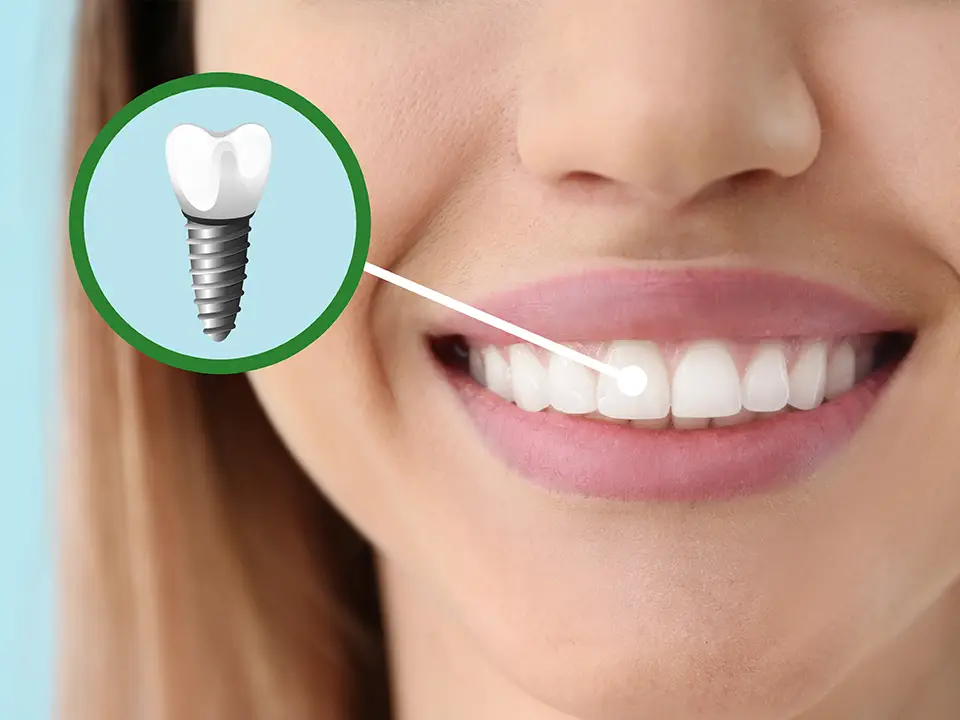
Your smile holds a lot of power, much more than you realize. A smile can change the world around you. It can solve disputes between you and others. It can help you start new relationships and even help you show affection to those you love. However, your smile can’t do these things if you’re not taking good care of your dental health, in fact it can cause a lot more strife than success. No one wants to see you smile if you have chipped, crooked or decaying teeth. Fortunately for you, it’s never too late to restore your smile and feel good about it! Dental implants are a revolutionary solution that’s become the go-to method for replacing missing or problematic teeth. While the procedure itself can span around 6 months, dental implants are a lifetime solution that’s absolutely worth the wait. If you’re not happy with the way your smile looks at the moment, here’s every reason to consider dental implants and where you can find them at an affordable price. Dental Implants vs. Dentures There aren’t many options to begin with for restoring a smile. The two primary solutions that come to mind are dentures….and dental implants. Modern dentures have been around a lot longer than dental implants. However, dentures aren’t the solution they were meant to be. So, let’s compare the two solutions to see which one is better. To start off, dentures are difficult and tedious to maintain. Unlike dental implants, dentures require daily removal for cleaning. If you plan on taking care of your dentures, that’ll require you to use unique cleaning solutions on a regular basis. A sticky adhesive is necessary to fixate a denture inside your mouth and even then, there’s a good chance of a denture slip at the worst of times. Dentures do little to prevent your gums from receding, causing them to get looser and looser, eventually forcing you to have to go back to the dentist and receive new ones that’ll fit until the cycle repeats itself. Above all else, you can’t eat what you want to eat with a denture. You have to avoid foods that can potentially break or stain your teeth, leaving you with a limited amount of options as to what you can have as a meal. Dental implants bundle up all the negative things about dentures and throws it out the window. For one, dental implants are a permanent solution for missing tooth and any dental problem. You won’t have to worry about a dental implant ever falling out or having to take it out for its own special cleaning. On top of that, dental implants are extremely durable. They allow you to eat what you want to eat without fear of them falling out, and they won’t shift in your mouth. Lastly, dental implants are more affordable. When comparing costs of both dental implants and dentures in the long run, dental implants will cost far less then denture upkeep. In the end, you’ll save money, feel more confident and have an awesome smile when you choose dental implants over dentures. Dental Implant Candidature There are plenty of denture users or edentulous persons who benefit from getting dental implants but assume dental implants are not suited for their needs. Dental implants are available for anyone with missing teeth or a damaged smile and are looking to permanently restore their smile. While there are some prerequisites to getting a dental implant, including bone grafts and possible sinus lifting, dental implants are possible in nearly all cases. At ADHP, our team of dentists will first examine you during your Free Consultation to determine your bone density and what’s necessary before a dental implant procedure. Dental implants are the best solution out there, but there are some risk factors that may impede the dental implant process or cause failure later on. Smoking, diabetes, radiation therapy and degenerative bone disorders can significantly hurt your chances of dental implant success. You’ve got to take care of yourself before you can take back your smile. There are plenty of methods to curb smoking. Talk to your doctor to see if diabetes or any other health deficiency are bad enough to prevent you from seeking out dental implants. Once your past these problems, you’ll be happy to know 98% of all dental implant cases are successful! Are You Ready to Get Dental Implants? Your journey towards a dental implant is about to start! If you’re missing a tooth or are looking to restore a cracked or decaying one, dental implants is the right way to go. When it comes to the whole process, ADHP makes it easy. We’re one call away from scheduling a Free Consultation. We’ll explain to you the entire process, and you’ll come to understand how straightforward and painless the whole procedure will be! Not only that, ADHP goes above and beyond to provide you affordable dental implants. Beyond our affordable pricing, we offer a plethora of financial options so you can enjoy your new teeth in the end without worry! The entire procedure will take around 6 months due to a lengthy healing period between the initial placement and final crowning of the dental implant. So, if you’re looking at getting one or more new teeth, it’s better now than later to schedule your initial appointment! Contact us online or by phone at (800) 959-3732 for more information and to start on the path to a new smile.
Start Flossing Today and Prevent Tartar Build Up!
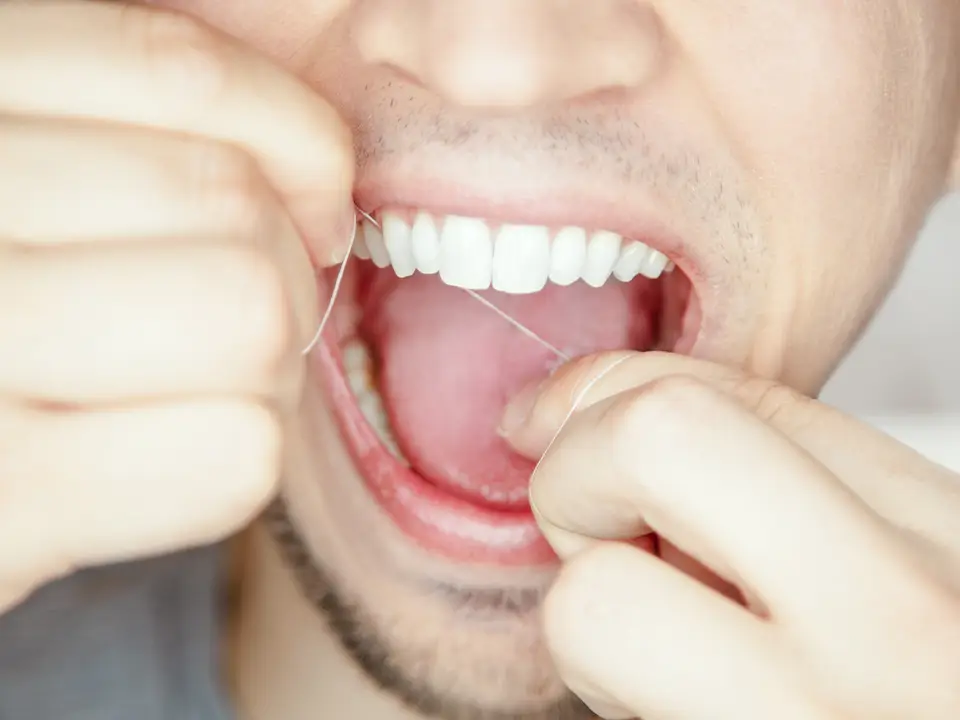
We develop dental habits at an early age. After years of constant nagging from parents and dentists alike, the vast majority of us learn the importance of brushing our teeth twice a day. For the most part, we do a good job sticking to a decent toothbrushing routine. However, one thing that dentists stress out more than anything, yet a lot of people continue to ignore is the importance of flossing. News flash – Flossing is just as important as brushing your teeth! Based on a survey conducted by the American Dental Association (ADA), only 16 percent of Americans are flossing at least once a day. Over half of those surveyed believe flossing to be a waste of time and admitted to exaggerating about how much they floss when asked by their dentist. There’s a giant stigma floating around flossing and that it’s gross, painful and not exactly necessary. That’s the problem though, we’re not flossing enough to take advantage of what it’s meant for – to keep your teeth clean! Flossing is a tool everyone should utilize in the bigger fight against tartar buildup. See, no matter how much you brush your teeth, the bristles are unable to give the sides of your teeth the cleaning they deserve. As a result, the ever-present bacteria inside your mouth accrues in the gap between your teeth over time, forming plaque. Dental plaque is pretty easy to deal with, but that requires you to brush AND floss your teeth every day, alongside biannual visits to your dentist for a deep cleaning. The problem that surfaces though, is the hardening of plaque into tartar above and below the gumline. Tartar is a huge problem many Americans face. Unlike plaque, tartar is hard enough to the point where a toothbrush and floss aren’t enough to make it go away. You’ll have to go to your dentist to have them break up the tartar using their cleaning tools. When left unchecked, tartar becomes a primary source of bad breath, tooth pain, discomfort and eventual bone regression. To sum it up, tartar is bad for you but by flossing you can stop it! Make it a goal to prevent tartar from taking over your teeth. The most important things to keep in mind are of course brushing your teeth twice a day for two minutes and remembering to floss! Even if flossing feels like too much of a hassle for you, make sure you stick with it. For some people, treat it with the same mentality as you do with your physical health. You go to the gym for the sake of being healthier, what’s to stop you from spending a couple minutes every day flossing your teeth? The best part about flossing is that it isn’t as painful as people make it out to be. With the right technique, you could finish flossing in as little as a minute. It’s really that easy, just look. Take 18” of floss and wind it up around both of your index fingers until you have about a hands length. Using a curved motion, move the floss up and down a couple times between every tooth, stopping right at the gum line. Gently move the floss around the base of the tooth and under the gumline, but don’t snap or force the floss down to prevent any bruising or bleeding. Move on to the next tooth, making sure you use a clean section of floss to prevent the transfer of plaque from one tooth to the next. In addition to flossing, there’s a few other ways you prevent tartar from building up. Visit the nearest store and pick up some special tartar controlling toothpaste, in addition to a non-alcoholic mouthwash for killing harmful bacteria. Lastly, if you’re an avid smoker, there is no better time than now to quit smoking. Smokers are more than likely to have tartar buildup compared to non-smokers. Flossing Tartar While brushing is essential for cleaning the surfaces of your teeth, flossing plays a critical role in preventing tartar buildup between teeth and below the gumline—areas your toothbrush simply can’t reach. Tartar, which is hardened plaque, forms when plaque isn’t properly removed through daily flossing and brushing. Once tartar develops, it bonds strongly to tooth enamel and can no longer be removed at home. By flossing at least once a day, you remove the sticky plaque before it has a chance to harden into tartar, reducing your risk of gum disease, cavities, and bad breath. Regular flossing is one of the simplest yet most effective ways to maintain a cleaner, healthier mouth and avoid costly dental procedures down the line. What will you do next? With good dental habits including flossing, you give yourself a better chance of having healthy teeth down the road by vastly reducing the chance of plaque building up into tartar. After all, tartar is hard to get rid of without the help of your dentist. That makes it all the more important you go.
Stop Feeling Down About a Missing Tooth and Get a Dental Implant!
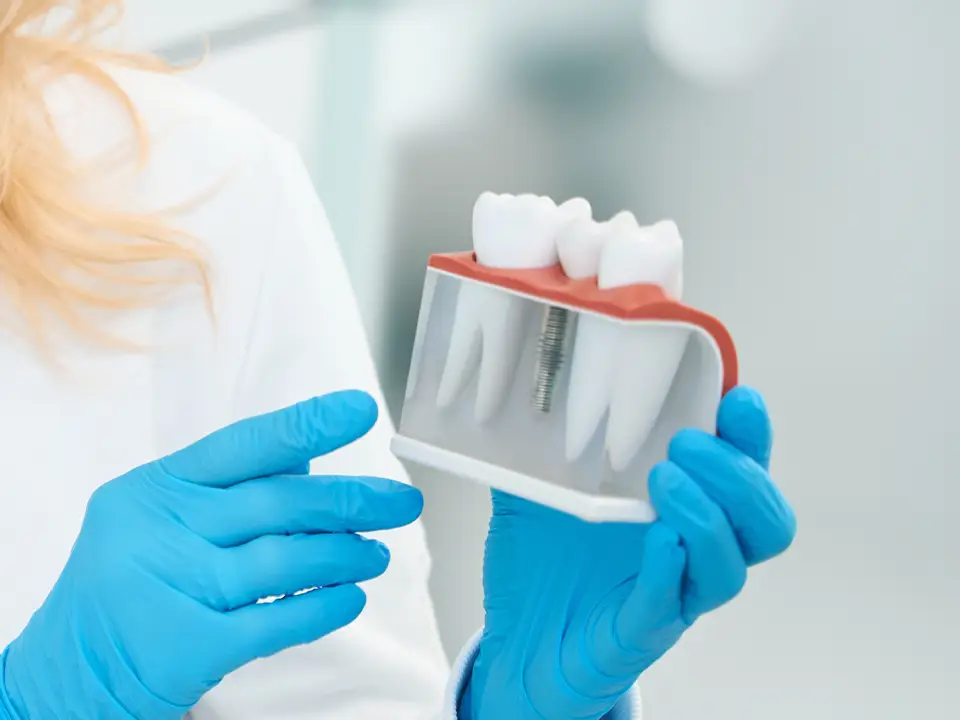
Smiling is one of those things you do without really thinking about. Whether you’re laughing at a joke or are just in a good mood, smiling is bound to happen. It’s healthy to smile and nothing should take that away from you. However, a missing tooth can change all of that. Not only will you be aware of when you’re trying to smile, you’ll go to incredible lengths to cover your mouth out of sheer embarrassment! At times, missing one or several teeth can feel like the end of the world. This doesn’t have to be you. If you’re relating to this situation all too well, there’s a solution for you we want you to take advantage of today – dental implants. Look Here If You’re Missing a Tooth No option other than dental implants even makes the discussion for being the best solution for restoring missing teeth. Dental implants are widely known for being a permanent, fixed solution that feels natural and blends in with your smile. They’re a perfect fix for anyone with one or multiple missing teeth, whether you’re straight out of school or well into your senior years. Unlike other solutions (including dentures and bridges), dental implants aren’t known for causing problems Dentures are notorious for accidental slippages, annoying maintenance and annual refittings. Bridges rely on neighboring teeth to support it, wearing them out and can cause further tooth loss. Both of these alternative solutions are outdated, they’re what your parents relied on before dental implants gained popularity. Let’s forego these not-so-reliable solutions and refocus on dental implants. Here’s a breakdown of all the perks you get out of dental implants: Dental Implants Prevent Bone Loss – An awesome perk of having dental implants is its ability to stabilize your jawbone. When you lose a tooth, the portion of your jaw once held in place by your tooth begins to recede, which can cause a ‘sunken’ facial appearance. Dental implants fix all that. Thanks to their ability to osseointegrate, dental implants prevent this process from happening, strengthening your jawbone through stimulation from speaking and eating. You won’t have to worry about getting a dental implant refitted every year or so to combat jawbone recession. Dental Implants Make Eating Easier – If you haven’t been able to eat your favorite foods in a long while thanks to the pain caused by a missing tooth or the limitations of dentures and bridges, you need no longer wait! Dental implants fully restore your chewing power. This is awesome, especially when compared to the lowly 40% chewing power dentures provide. Chewing power is everything, it’ll help alleviate any digestion problems you’ve been experiencing. Best of all, you don’t have to worry about trapped food beneath your teeth or having your teeth embarrassingly slip out while eating. Dental Implants Don’t Require Special Care – One perk of switching to dental implants from dentures or a bridge is how easy it is to clean them. Dental implants only ask you to take care of them the same way you’d take care of the rest of your teeth. That’s easy! Brush your teeth twice a day for two minutes, floss your teeth daily and visit your dentist every 6 months for a deep cleaning. Dental Implants Restore Your Confidence – When you get a dental implant, you no longer have to feel down about your smile. You’ll be brimming with confidence, smiling without worry and you’ll no longer feel like you have to shield your face around family and friends! Every time you look in the mirror, you won’t even be able to tell which of your teeth are actually dental implants! Dental Implants are Affordable! This year, over 2 million patients in the United States will choose dental implants as the solution for their missing tooth woes. What about you? There are zero excuses for you not to consider getting a dental implant if you’re embarrassed of your smile due to a missing tooth; not even pricing can stop you. Nowadays, dental implants are affordable! Here at ADHP, we understand not everyone has huge spending power. That’s why we strive to provide the most affordable, transparent dental implant pricing in all of Southern California. Unlike most dentists, we make sure you can see our dental implant pricing right on our website, so you know exactly what you’re paying for without second guessing the price. We even offer a Free Consultation for anyone looking to get a dental implant! Compare that to other dentists, who want you to pay for a consultation before they even quote you for the procedure. Note: There are a few cases where dentists promote ‘free’ dental implants, but we cracked down on these dentist and warn you of how much they really charge. Dentists can be affordable, but if they’re free or a price that’s seems to good to be true, don’t be surprised when they hit you with a surprisingly expensive bill in the end. Get A Dental Implant Today! If you’re missing a tooth, you’ve no reason not to get a dental implant. At ADHP, we offer a variety of financing options on top of our unbeatable dental implant costs. We’ll work with you so you can walk out of one of our six locations wearing a newfound smile on your face worry-free. Contact us online or by phone at (800) 959-3732 and we’ll set you up with a Free Consultation. It’s okay to smile now, getting a dental implant will change your life for the better forever.
7 Tell-Tale Signs You Need a Dental Implant
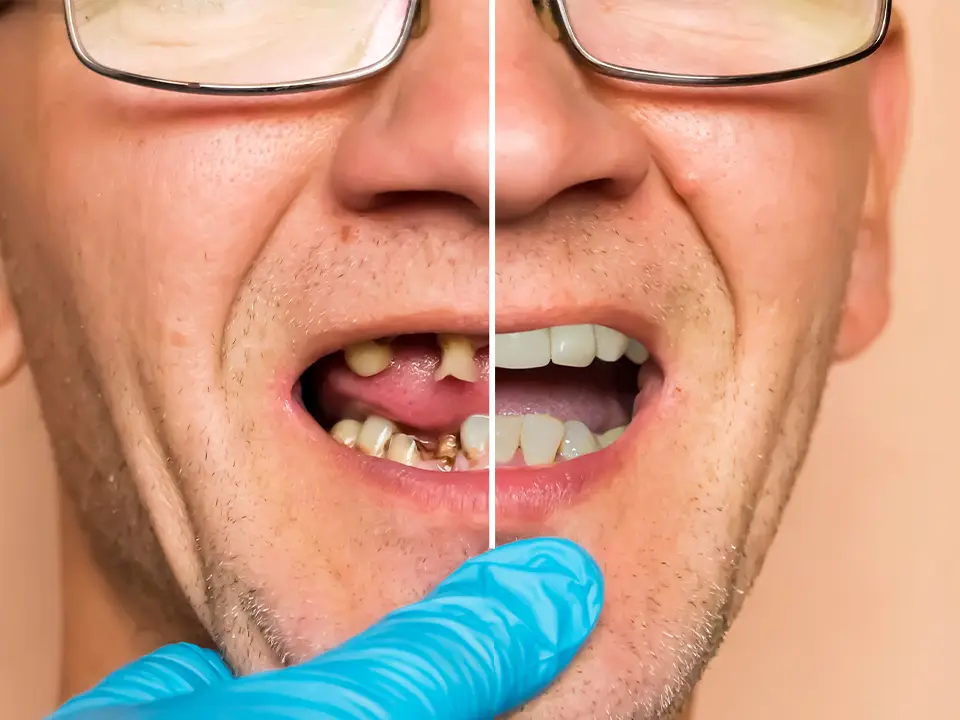
You can no longer ignore dental implants. Simply put, they’re the best solution out there for dental restorations. Patients turn to dental implants rather than alternatives such as dentures for many reasons. Dental implants are comfortable, they’re permanent and they boast a 98% success rate. It’s one less thing to worry about (provided you take care of them properly), which is why we’ll see over a million people get one or more dental implants this year alone. Do you think you need a dental implant? Follow these 7 tell-tale signs to find out. 1) You’re Missing Teeth! This one should be obvious. If you’re missing one or multiple teeth, you cannot ignore the problem for long. Not only is a gap in your smile absolutely embarrassing, it can be painful to eat, hard to speak and you can lose even more teeth! You can smile with confidence again with dental implants. For one, even with a close look in a mirror you won’t even be able to tell you were ever missing a tooth in the first place! Secondly, you won’t have to worry about any problems surfacing when you’re eating or speaking. To top it off, a dental implant will help diminish the chances of losing more teeth down the road. 2) You Have a Loose Denture Embarrassing denture slips don’t just happen in movies, it happens quite often for a lot of denture wearers! Having a loose denture or partial can be very troublesome and can drive anyone wearing them mad, especially when they fall out at the most inopportune of times. It constantly feels more like a plastic block than teeth in your mouth. You’ve constantly need to get a denture refitting every couple of years because dentures do nothing to stop jawbone recession. Dental implants fix all the problems you may have with dentures. They’re a permanent solution; you won’t have to worry about them ever coming loose or falling out at random. A single dental implant feels just like a natural tooth, so no more bothersome blocky feelings. Plus, dental implants dramatically help your oral health starting the moment the procedure is complete. 3) Your Tooth Has an Infection If you have a tooth infection, there’s two options a dentist will give you. Either they’ll first try to save it through a few unique procedures or go ahead and say your teeth requires an extraction. If an extraction is necessary, it’d be the best time to start looking at dental implants. A dental implant is the perfect solution for replacing an infected tooth. Thanks to its composition, dental implants are extremely strong and as durable as natural teeth. Another amazing advantage is they require no special care besides brushing your teeth twice a day for two minutes and flossing. 4) Your Face is Starting to Sink In Remember how we said dentures do nothing to stop jawbone recession? That’s because dentures do little to stimulate the jawbone to stay intact and regrow critical tissues. The result? A sunken-in facial appearance, something denture users find themselves feeling embarrassed of when looking in the mirror. Don’t turn into a live depiction of The Scream painting! The solution is dental implants! Dental implants do an amazing job of stimulating the jawbone where your missing teeth once were, especially when you bite and chew your food. If necessary, you may need to have some bone grafting done prior to getting a dental implant. That’s because the dental implant has to have some bone around it to successfully osseointegrate and remain fixed in place. 5) You Have a Broken or Cracked Tooth It’s painful dealing with a broken or cracked tooth, fortunately you don’t have to deal with the pain for long. If the damage isn’t too terrible you may only have to get dental a crown. However, if the tooth is too far gone you will have to get a dental implant. There are several scenarios where getting a dental implant is better than just a crown. If the tooth breaks beneath the gum line, you’ll have no other choice than to extract the tooth. Another situation is where the tooth has damage inside the pulp. When you come in for a Free Consultation, one of our dentists here at ADHP will help evaluate your case and determine what solution works best for your needs. 6) You Can’t Eat Your Favorite Foods Missing teeth makes it really hard to eat your favorite foods. Unless you want to painfully gum your food down, you have to chew slowly and tenderly as well as avoid some foods altogether! This fact is hard to swallow, but dental implants can help you out of this situation! Thanks to dental implants, you’ll be able to eat whatever foods you like without a problem! Dental implants restore your full chewing ability making it simple to eat what you want to eat. 7) You’re Insecure About Your Smile No one wants to feel insecure about their smile. For many patients, having a denture, bridge or partial has only brought them shame and embarrassment. You should feel confident in your smile, one that you’re ready to flaunt during outings and pictures with family and friends. That’s why dental implants are so great! Dental implants won’t stand out, they’ll look just like your natural teeth! Plus, they’re a huge confidence booster. You’ll no longer need to hide your smile or hold back a laugh when you’re out with friends, so go ahead and smile now! What’s Next for You? If you are facing any one of these 7 problems, now is the time to get a dental implant! Dental implants are available for an affordable price, right here at ADHP. We have 6 convenient locations throughout Southern California, making it easy for you to get dental implants without having to travel far. Our doctors are more than able to answer your questions, give you advice and help you restore your smile. Give us a call or fill
Don’t Fall for Free Dental Implant Scams
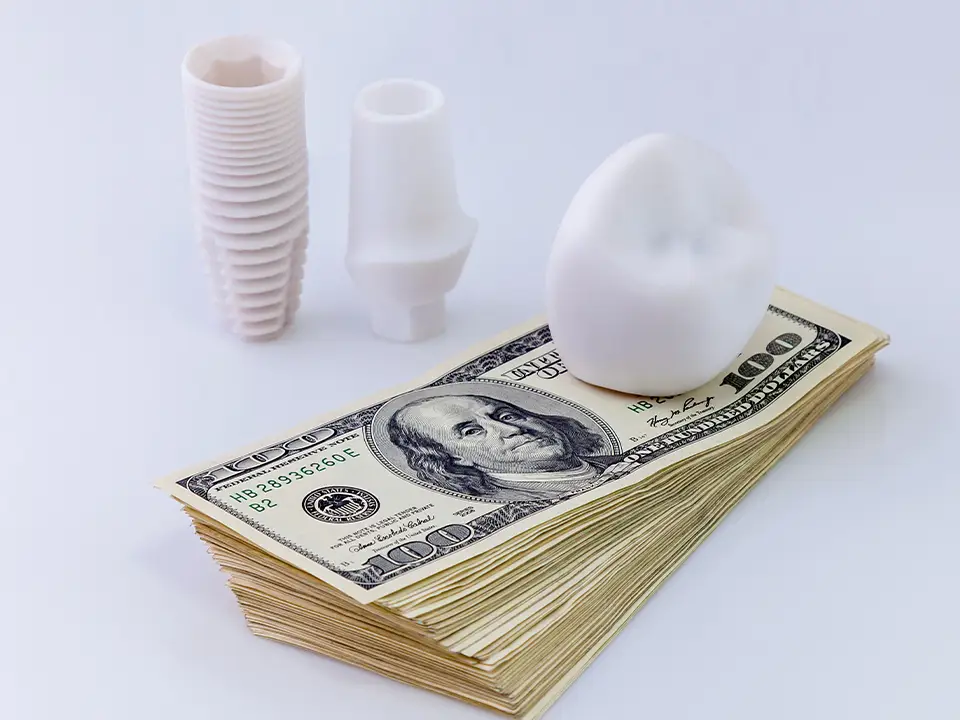
Dental implants don’t come free. If you’ve done any research looking for a dental implant to restore yours or another’s missing tooth, you’ll catch on quickly to the fact its hard to find the information you need. This includes dental implant costs and information about the dentist. While we make both pieces of information readily available here at ADHP, we want to warn you about the large amount of misinformation there is out there. There’s a huge game dental advertisers are playing right here in our area. Whether its through their own articles or their blog posts, they try their best to lure you with false information coupled with hidden details. Dental practices like these make you join some sort of list or program, then afterwards give you more information that you needed to know firsthand. They certainly play with your emotions, describing how easy it is to get the best solution – dental implants – for next to nothing of a price. Then, only after they’ve got you in their office for the procedure will they list out a whole bunch of charges and hidden fees you came in knowing nothing about. These dentists have been playing this game for a very long time, they know unsuspecting patients are the easiest to make their money off of. Of course, you don’t want to be the one that gets an awesome quote and have a large bill suddenly appear out of nowhere. This usually happens when dentists advertise their dental implants as absolutely free. Let’s be honest though, nothing is free. That’s why we’re going to help you get to the bottom of all this madness. Today, we’re going to dive into dental implant costs so you can identify an affordable solution when you see one. The Truth Behind Dental Implant Pricing Don’t get too excited and pumped up over a dental implant price that’s too good to be true. You’re just preparing yourself for disappointment. The truth is, there are plenty of dentists out there that promise free dental implants but fail to keep their word when the procedure time rolls around. That makes sense, since dental implant parts don’t come free for dentists and their time has to be worth something. Here’s the deal. A dental implant breaks down into several parts – the implant post, abutment and crown – each costing money. On the lower side of the price spectrum, dentists can purchase low quality implant parts in bulk for next to nothing. These low quality parts are cause for concern, as they’re a primary reason for dental implant failure. Now, if we look at the upper end of the price spectrum, dentists purchase high-quality implant parts meant to last a lifetime. Combined, the parts for a single dental implant can round off near $1000. In California alone, dental implant prices range anywhere from to $9200 each. That’s a huge range of prices, and you can find a wide spread of them just minutes down the road from each other. The final price the dentist will charge you depends greatly on the services you need leading up to the dental implant procedure, including bone graphing and sinus augmentation. Lastly, the dentist can add to the price tag whatever they feel their time and service is worth. Given the ‘expensive’ nature of dental implants, where the bill can reach tens of thousands of dollars if you’re looking to replace multiple missing teeth, it’s no wonder there’s people that’re looking for free dental implants. It’s just that, dental implants aren’t free. Even here at ADHP, we’ve already made dental implants affordable and offer a variety of financing options to pay over time, but they aren’t free. How to Identify Free Dental Implant Scams So far, we’ve established dental implants don’t come free. Why is it then that dentists still offer ‘free dental implants’ to bait patients into their doors? It’s because they know these magical words will get people sitting up in their chairs and get them to book an appointment online or by phone. Of course, not everything is pretty from there on out. They’ll point out the tiny, fine details placed strategically so it doesn’t distract you from the free dental implant pitch. While most people do realize how much of a scam that practice is and don’t sign up for the dental implant procedure, there remain some people that blindly continue thanks to a dentist’s hard sell points. Another hard tactic dentists push onto their leads is separating the cost of the dental implant materials from the actual service fee. As such, they’ll tell you the dental implant is absolutely free, then just charge you the whole amount as the service fee. Turns out, this can be quite expensive. For anyone that falls into this trap, not only will you pay the full price for a dental implant, the dentist doesn’t have an actual limit to their ‘service’ fee. They can charge you however much they want, and it won’t matter because you already signed off on the procedure. In scams like these, the dentist won’t tell you of any additional fees, like X-rays and laboratory fees. Depending on if those services are in-house or not, that’s another few hundred dollars tacked onto your final receipt. The pricing may look legit in the end, but you’d have no idea if the dentist inflated those prices or not. Remember, the dentist is in full control of what they charge you for their services. When you see that free dental implant advertisement, know that it’s just a doorway for the dentist to receive a hefty payout. Finding Affordable Dental Implants Without A Problem No dental implant is going to be free. If you think a dentist is going to spend thousands of their dollars to buy implant parts and place them for absolutely nothing in return, you’re wrong. Rather, with some time and research you’ll learn of affordable options for dental implants. We’ve done the research in
Pricing of All on 4 Dental Implants in Southern California

We don’t recognize the importance of our smiles until we no longer have one. Losing multiple teeth can be detrimental to our health and wellness, making us feel shameful to smile freely. Even with advancements in medicine and technology, we still see ourselves losing an average of 7 teeth between the ages of 35 and 49. Do you want to live the rest of your life without teeth? Do you want to get your confidence and your smile back? If you do, All on 4 dental implants is the solution for you. In this guide, we want to show you where you can find All on 4 dental implants for the best price in Southern California. Save Money on All on 4 Dental Implants Just as you would while shopping for anything else, you want to get the best deal on All on 4 dental implants, but finding the best deal can be time consuming to say the least. We know how tough it can be to compare prices from different dentist from city to city without spending countless hours in waiting rooms. That’s why we’re here today with pricing for All on 4 from over 200 dentist in Southern California. The infographic below depicts the average the price of All on 4 dental implants, as well as the spread in pricing. *Note* Our data on All on 4 dental implants does not represent every dentist in Southern California. Not all dentists offer All on 4 dental implants in their office. Are the prices what you thought them to be? It’s a common misconception led by outlying prices that All on 4 dental implants are only for the upper-class. That is simply not true! Fact is, the average cost of All on 4 is only $29,400 and is as low as $19,995 in cities like Westlake Village. There’s savings up to $34,000 on All on 4 dental implants in Southern California. Those savings are what you can put towards a brand new car. You don’t need to mortgage your house or pull out of your retirement funds to restore your teeth! There’s plenty of funding options available in-office that give you plenty of time to pay before, during and after the surgical procedure. Now you know the price of All on 4 dental implants, next you need to understand what factors into the costs. Factors that Affect the Cost of All on 4 Dental Implants Two big surgical factors that comes to play is whether you need multiple extractions or bone grafting. Extractions per tooth can cost between $60 and $450. The cost difference is apparent especially when you need multiple teeth pulled prior to getting a CBCT scan around your mouth. Bone grafting, often used to restore bone loss, can tally up to be $750 depending on where you go. The price for both of these services fluctuates from person to person as each case is unique. There remains one big factor, and that is the dentist. For many years, dentist work for their medical degrees, their board certifications, and eventually to establish their own practice. It’s thousands of hours of work on their side, and they want it to pay off. While the overall cost of materials hovers around $18000, many dentist skyrocket their prices to get as big of a profit as they can. This is why you such a spread in the price spectrum, each dentist values their time differently. Of course, some dentist would rather provide affordable dental care, and highlight the most affordable prices on our list. These dentist may not be making much of a profit, but they’re doing what they love, which is providing affordable All on 4 to those who need it. Get Your Smile Back Here in Southern California Your smile is important to you, so why not take full advantage of affordable All on 4 dental implants? You’re going to get the best deal on All on 4 dental implants right here in Southern California. Ready to get started? Contact us today and we’ll work with you to restore your smile in no time.
A Complete Guide of Dental Implant Costs in Torrance, CA

Modern dental implants have been around since the 1960s, but has only proven their worth in recent years. Before they became popular, dental implants used to be incredulously expensive and out of reach for the majority. Back then, it was easier and cheaper to just get dentures than deal with the complexities of dental implants. Nowadays, dental implants are the recommended solution for replacing missing teeth. Dental implants are number one in restoring a tooth and giving you back a smile you’ve been living without. The cost of dental implants has seen a change in scale, with more dentist realizing that dental implants should be available for everyone. Are you looking for information on the best dental implant prices in Torrance, CA? We took care of that for you! In this guide, we want to educate and give you all the information we have collected about dental implant pricing in the city of Torrance. Cost of Dental Implants In order to provide the most reliable information about dental implant prices, we collected over 500 dental implant quotes from dentist all in the city of Torrance. There’s a dentist on almost every block, so it’s important that you know where you can find the best and cheapest price on dental implants there is. So how much are dental implants in Torrance? We took a look at our research and made some calculations. The average cost for a single dental implant is $3768, about half a grand less than the average in California and a little more than half the average in the United States. That’s great especially if you’re looking for a cheaper solution. However, we aren’t done! Though the average cost of dental implants in Torrance is $3700, the highest price is $6000 and the cheapest one is . That’s a huge spread in price! You can plan a trip to Cancun with what you’re saving! The prices we collected include every part of an implant – the implant post, abutment and crown. Reason we say that is there are advertisements out there that promote $399 implants, but truthfully they are only selling you an implant post. How does a single implant post solve your missing tooth problem? If you are looking at dental implants, you want to make sure the dentist does the complete dental implant procedure at their practice. Save yourself the time and stress of going from dentist to dentist paying for consultations only to find your options are way overpriced. We ask you refer to our data when looking for dental implants and find yourself the best, most affordable dental implants in Torrance, CA. Extra Procedures We’ve given you the price of a single dental implant in Torrance, and while the prices will stay the same, any extra procedures may make you have to flex your budget. With most dental implant procedures, many patients are required to take an extra step – a bone graft, a gum graft, a sinus lift or a combination of the three – in order to repair and help you recover from having lost a tooth prior to getting a dental implant. A patient will usually need a bone graft if there has been an extended time span between losing a tooth and requesting a dental implant. Gum grafts are usually needed for patients to repair the gum after battling periodontal disease. Sinus lifts are less common but are used to raise the position of the upper jaw, allowing it to be more supportive for a dental implant. These procedures can be as little as $500 and as much as $3000. No need to worry! These procedures are worth it to get a dental implant and restore any missing teeth. Dental implants have such a high success rate (over 95 percent) because of procedures like these. Your dentist in Torrance will go over your X-rays with you and tell you if you need to get one or more of these procedures. Factors that Affect the Cost Of course the cost of dental implants can also be affected by many more factors other than just extra procedures. Here’s a list of some of those factors: The material of the implant post, abutment and crown. How many and which teeth you are looking to replace. The education, experience, and popularity of the dentist. Laboratory Fees Any tooth extractions needed to take place prior to placing an implant. Out of those 5 factors, #3 is the main reason there’s a huge spread in pricing in our research, and why not every implant practice in Torrance offers dental implants for as low as . This is because these dentist overcharge their service to make up for the vast amount of time and money they’ve put into their education and research. Truth be told, a high quality implant, one that consists of a titanium implant post and a porcelain is as much as $1200 for the dentist. That’s it! It goes to show how greedy some practices can be when they jack their pricing up to $6000 an implant. Make the Right Decision Whether or not you seek out the dentist on this list is up to you, but we can only assure you that these prices are accurate and are the cheapest and best dental implant practices in the city of Torrance. We hope that with this guide, you will be more educated than you were prior about dental implant pricing. Dental implants are the number one solution for restoring a missing tooth, and we want you to be confident in getting one when the time comes to choose an implant practice. For more information, feel free to contact us through our online form, or by phone at 1(800) 959-3732.
How is Sparkling Water Affecting Your Teeth?
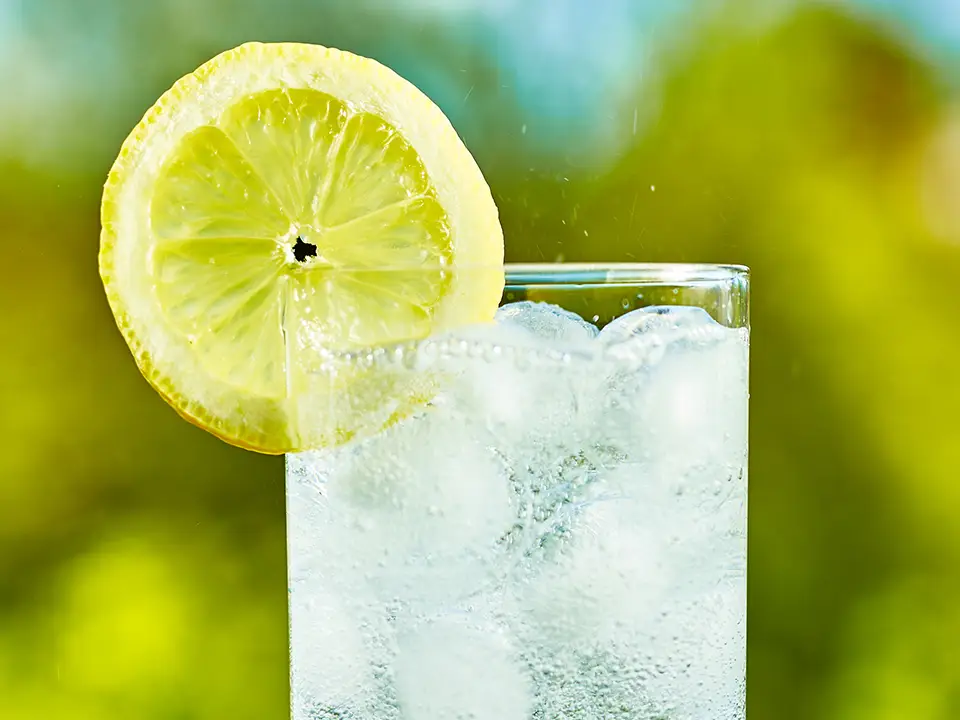
Picking up sparkling water can be almost as addicting as binge watching your favorite Netflix shows and going out to that one restaurant you love every week. Sparkling has definitely become one of the favored alternatives to drinking regular water and passing on the soda. It’s actually a common belief that sparkling water is good for your teeth, and it’s true. Carbonated water may not be as great as regular water, but is certainly better than drinking soda. We took some time to look at what sparkling water and its effects, here’s what we found out. The Effects of Sparkling Water on Your Teeth The fizzy, tangy sensation of sparkling water may seem really great to gulp down as you’re quenching your afternoon thirst, but there’s a lot of mixed feelings. Here’s how sparkling water is affecting your teeth. What is Carbonic Acid and How Does it Affect Your Teeth? It starts with how it works. Sparkling water contains no sugar, so how it gets its flavor is through a chemical reaction that produces carbonic acid. Carbonic acid may not seem so bad, as it’s the same acidity level as lemons, but you wouldn’t squeeze fresh lemon into your mouth now would you? Carbonic acid is much more than just a name. Drinking excessive sparkling water allows the carbonic acid to disrupt the pH balance in your mouth, causing major damage to the enamel of your teeth. It’ll cause enamel to erode, and expose the dentin that lies underneath it. Enamel is the part of your teeth that keeps it protected and pearly white, and once it’s gone it is gone. How Can You Keep Your Teeth Healthy While Enjoying Sparkling Water? If you’re worried that carbonic acid will have a toll on your teeth, there are many ways for you to help out your teeth while continuing to enjoy sparkling water. Keep in mind that we said, “drinking excessive sparkling water.” Like many other drinks, if you keep it into moderation, and give your teeth the daily care that they deserve, you shouldn’t have to ever worry about the dangerous effects of carbonic acid on your teeth. So if you’re one of those who like to only drink sparkling water, it may be time to look at regular water to stay hydrated. First off, use a straw! By using a straw, you can minimize the amount of carbonic acid that has contact with your teeth and thus protecting your enamel. Drink your sparkling water with a meal. By limiting yourself to a glass of sparkling water during fulfilling meals, you save yourself a lot of toothaches down the road. That is because eating will cause an increase in saliva production, thus saliva can neutralize the acidity levels of sparkling water as you take it in with your food. If you plan on drinking sparkling water close prior to going to sleep, make sure you give yourself enough time, preferably 30-45 minutes before brushing your teeth and getting into your bed. This is because your teeth will be slightly weakened right after you drink sparkling water due to the acid levels, and can be permanently damaged if you brush your teeth while it’s in a weak state. How is Sparkling Water Affecting the Rest of Your Body? Surprisingly, if you’re able to take care of your teeth, sparkling water is really not that bad for you. In fact, sparkling water has other health benefits you probably never knew about! You Will Have Stronger Bones It doesn’t seem like sparkling water would have many other benefits, but in fact sparkling water is great for your bones. In a closed study, those who drank sparkling water has a slight increase in calcium retention in their bones compared to the control group who only drank water. On the other side of the spectrum, those who drank sodas were found to have a huge calcium deficiency. Why is this caused? Sodas have a high concentration of phosphorous, which is not good on your bones at all. Regular and sparkling water contain very little to no phosphorous. We conclude that sparkling water is just as good for your bones as regular drinking water, and is certainly better for your bones than soda is. Your Heart Can Benefit Too There are arguments about sparkling water being beneficial for your heart, and there exists some evidence that may back it up. If you are looking to skip out on heart problems, drink sparkling water will lower your chances of developing cardiovascular disease up to 35% in comparison to regular water. There has also been a recent study consisted of 18 people that measured the effects of sparkling water on heart health. LDL (bad) cholesterol, inflammatory markers and blood sugar all decreased in each subject, while there was an increase in HDL (good) cholesterol. The benefits of drinking sparkling water sure seems to favor great heart health, but needs to be studied a lot more in order to affirm this statement. It May Improve Your Digestion The last thing anyone would’ve thought sparkling water would beneficiate would be the digestive system. Sparkling water actually improves the functionality of your digestion system in several ways. Sparkling water is directly linked to improved swallowing abilities in both younger and older adults. It demonstrates the greatest ability to cause the maximum nerve stimulation used for swallowing. This is especially good news for those who consistently clear their throats. There are current studies being piloted that are studying sparkling water’s effect on you feeling full. It’s backed by the assumption that sparkling water keeps food in the stomach sac for a longer duration, which can trick your body into thinking you’re sated. Current studies are showing positive results, but further testing needs to be conducted before we can confirm it. Sparkling water may also be a way to relieve people of constipation. Already there has been a study consisted of 40 people, 58% of them reported back that sparkling water decreased

